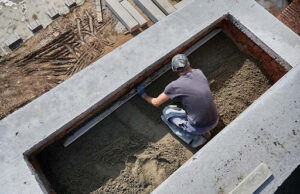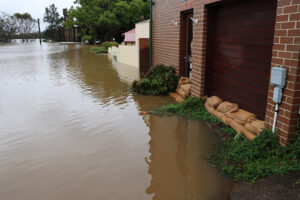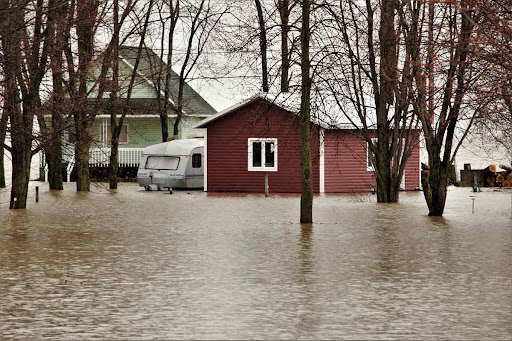Protecting your home from floods is paramount in safeguarding your property and loved ones from the destructive forces of nature. Floods can result in significant damage, emotional turmoil, and financial setbacks, making preparedness a vital aspect of homeownership.
In this article, we will unveil the top 5 crucial defenses that every homeowner should consider to fortify their residence against the potential ravages of flooding. These defenses form a comprehensive strategy to ensure your home remains a secure haven even in the face of rising waters.
Defense 1: Elevated Foundations
 Image Source: ArtPhoto_studio on Freepik
Image Source: ArtPhoto_studio on Freepik
Elevated foundations in flood protection involve raising a home’s base significantly above ground level, often achieved by using pilings, columns, or elevated platforms. This strategic approach creates a physical barrier, reducing flood damage risk and allowing water to flow beneath the structure.
Raising a home on elevated foundations provides significant benefits. It prevents floodwater from reaching primary living areas, saving repair costs and minimizing mold and mildew issues. Due to their reduced vulnerability, such structures often qualify for lower flood insurance premiums.
Numerous homes with elevated foundations serve as practical examples of flood defense. Coastal regions and flood-prone areas frequently feature houses raised on stilts or pilings, ensuring residents’ safety during floods. These homes showcase the effectiveness and resilience of elevated foundations in flood-prone areas.
Defense 2: Comprehensive Drainage Systems
 Image Source: fabrikasimf on Freepik
Image Source: fabrikasimf on Freepik
Effective drainage holds a crucial role in flood protection, diverting excess water away from your property to prevent potential flooding. It ensures that rainwater, stormwater, and other moisture are managed efficiently, safeguarding your home and its surroundings.
Different types of drainage systems are available to meet specific needs. Surface drainage systems, such as gutters, downspouts, and swales, manage water on the ground surface. Subsurface drainage systems like French drains and sump pumps handle water below the surface, preventing waterlogging. Understanding these systems and their applications is essential for tailoring your drainage strategy to your property’s unique requirements.
Maintaining and improving drainage is an ongoing task that can significantly enhance flood protection. Regularly inspect and clean gutters and downspouts to ensure they are free of debris. Properly grade your yard to encourage water flow away from your home. Consider installing permeable surfaces or rain gardens to absorb excess water. These simple steps and keeping your drainage systems in top condition can bolster your defense against floods.
Defense 3: Flood Barriers and Sandbags
 Image Source: Wes Warren on Unsplash
Image Source: Wes Warren on Unsplash
When it comes to flood protection, Defense 3 encompasses the use of flood barriers and sandbags, which serve as vital tools in safeguarding your property from rising waters. These elements work in tandem to create a physical barrier against encroaching floods.
Flood barriers, typically constructed from materials like metal, plastic, or concrete, form a barrier around your property, redirecting or blocking floodwaters. They are designed to be sturdy and resilient in the face of rising water levels. Selecting and installing the right flood barriers is essential; ensure they are appropriate for your specific needs and property layout. Proper placement and sealing are crucial to their effectiveness.
Sandbags, on the other hand, are a versatile and cost-effective method for temporarily preventing floodwater entry. They can be stacked and placed strategically in flood-prone areas to divert or block water flow. To use sandbags effectively, ensure they are properly filled, stacked, and positioned to create a secure barrier. Timely deployment and monitoring during a flood event are key to maximizing their effectiveness in protecting your home.
Defense 4: Home Flood Insurance
 Image Source: Mikhail Nilov on Pexels
Image Source: Mikhail Nilov on Pexels
Flood insurance is a critical component of flood protection, offering financial security in the event of flood-related damages. Its significance lies in providing homeowners with a safety net, as standard homeowners’ insurance typically doesn’t cover flood-related losses.
Flood insurance operates as a separate policy from your standard homeowners’ insurance. It works by offering coverage for structural and content damages caused by floods, whether they result from heavy rain, storm surges, or other water-related events. This coverage can include repairs to your home’s foundation, flooring, and electrical systems and the replacement of personal belongings damaged by flooding.
Obtaining flood insurance is a straightforward process. You can purchase it through private insurance companies or participate in the National Flood Insurance Program (NFIP), administered by the Federal Emergency Management Agency (FEMA). To secure flood insurance, you must provide information about your property’s location and elevation, which helps determine your risk level and premium cost.
It’s essential to weigh the potential cost of flood insurance against the potential financial losses from flood damage, as this coverage can be a vital part of your flood protection strategy.
Defense 5: Emergency Preparedness
 Image Source: Harry Cooke on Pexels
Image Source: Harry Cooke on Pexels
Emergency preparedness is a cornerstone of flood protection. A clear plan is essential for safeguarding your family and property in the face of flooding. It includes establishing evacuation routes, designated meeting points, and communication strategies.
An emergency flood kit is another key component. It should consist of non-perishable food, water, a flashlight, a first-aid kit, essential medications, vital documents, clothing, and personal hygiene items. Keep this kit accessible, periodically checking and updating its contents.
Understanding what to do before, during, and after a flood is crucial. Before a flood, monitor weather alerts and be prepared to evacuate if necessary. During a flood, stay informed through local authorities and follow evacuation orders. If you remain at home, move to higher ground and avoid flooded areas.
After a flood, use caution when returning home, inspect for damage, and document it for insurance claims. Be mindful of health risks from contaminated water and follow recommended cleanup procedures. Having a well-considered emergency plan and knowing these steps can significantly affect flood protection.
Wrapping Up
In conclusion, prioritize flood preparedness now to protect your home and loved ones. These defenses are essential, as floods can strike unexpectedly. Act today, whether by elevating your foundation, improving drainage, obtaining flood insurance, or creating an emergency plan and flood kit. Your proactive steps now ensure a safer future.



Leave a Reply